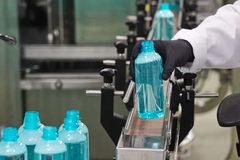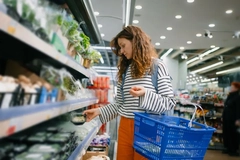Appetite Creative talks connected “revolution” in supply chain, sustainability and consumer engagement
02 Oct 2023 --- Connected packaging is transforming how companies manage their supply chains and engage with consumers, according to Jenny Stanley, managing director at Appetite Creative. Innovative software solutions now guide businesses in adopting reusable packaging systems, from material choices to optimizing processes.
QR codes and RFID tags allow real-time tracking, enabling operational improvements and sustainability gains without compromising data privacy.
We speak to Stanley about the potential of connected packaging in addressing challenges and opportunities presented by supply chain complexities and regulatory requirements.
She details that smart packaging offers authentication and traceability in a landscape where personalized packaging is gaining traction, driven by e-commerce. Two-dimensional QR codes are replacing traditional barcodes, offering additional data.
Additionally, Stanley shares that augmented reality (AR) and AI are shaping the future of connected packaging, providing interactive and personalized customer experiences.
How is connected packaging influencing supply chain management and logistics?
Stanley: A new frontier in sustainability efforts, software solutions have emerged to guide companies through the process of embracing reusable packaging. These platforms assist in decision-making on packaging type and materials to launch and optimize reusable systems.
 Serialized QR codes are unique QR codes assigned to individual product packages, enabling package traceability throughout the supply chain.By utilizing tracking methods such as QR codes or RFID tags, companies can gather valuable information on packaging location, monitor product flow, identify areas for operational improvement, deliver cost savings and improve environmental sustainability and strategic decision-making, without compromising data privacy. For packaging manufacturers, reusable packaging opens doors to new product development ideas and a shift toward a service-oriented model.
Serialized QR codes are unique QR codes assigned to individual product packages, enabling package traceability throughout the supply chain.By utilizing tracking methods such as QR codes or RFID tags, companies can gather valuable information on packaging location, monitor product flow, identify areas for operational improvement, deliver cost savings and improve environmental sustainability and strategic decision-making, without compromising data privacy. For packaging manufacturers, reusable packaging opens doors to new product development ideas and a shift toward a service-oriented model.
Transparency and consumer engagement are key pillars of successful reusable packaging systems. Companies can permit suppliers and supply chain partners to share verified data on packaging reuse. This data can then be made available to consumers through branded web pages or interactive dashboards, offering insights into the number of reuses and cleaning processes. Engaging consumers in this way fosters education, trust and participation in the reuse movement.
One popular tool is serialized QR codes, which are unique QR codes assigned to individual product packages, enabling package traceability throughout the supply chain. They can deliver supply chain traceability, quality control, sustainability monitoring and counterfeit product prevention. Additionally, they can track customer behavior and underpin loyalty campaigns.
While a static QR code is permanently linked to specific content, a dynamic QR code can be programmed with “active” content that can be adapted at different times of the day or in different locations.
Serialized QR codes allow suppliers to track packages at any point within the value chain. For marketing and sales teams, the benefits can include direct sales promotion. In the future, there is potential to integrate with the Internet of Things with QR codes triggering automatic product orders, but there are privacy laws and user data privacy considerations with this next iteration.
Are there any environmental concerns associated with the increased use of technology in packaging?
Stanley: The pressure for brands to act responsibly has reached a crescendo. The climate crisis has emerged as a critical concern across every industry, highlighting the need for sustainable practices, especially in the packaging industry.
In response to this urgent call, manufacturers and businesses are increasingly adopting environmentally friendly packaging solutions and exploring the potential of connected packaging. Aligned with environmental and policy considerations, connected packaging and the broader technology supporting it provide an intelligent way to make packaging more sustainable while educating and engaging customers.
A recent survey we carried out showed that increased investment in digital marketing spend is planned in 2023 by 88% of those surveyed vs.59% in 2022. The results showed that connected packaging is deemed increasingly necessary as a sustainable way to connect with and educate customers (57%). Almost half (44%) perceive it as becoming the main route to communicate directly with customers.
By empowering consumers, driving operational efficiency and fostering long-term resilience, these trends provide tangible solutions to mitigate the cost-of-living crisis while promoting a greener and more sustainable society. Appetite Creative is helping wineries with label design and implementing e-labels and QR codes.
Appetite Creative is helping wineries with label design and implementing e-labels and QR codes.
What role does data analytics play in optimizing connected packaging strategies?
Stanley: While the potential of connected packaging is immense, brands must overcome certain challenges. It is critical to understand the purpose and value of connected packaging, integrate it seamlessly within existing systems and manage supply chain complexities. Starting with pilot projects and gradually scaling implementation allows brands to learn, optimize and overcome barriers toward widespread adoption.
Brands that effectively integrate connected packaging solutions into their strategies will be well-positioned to meet evolving consumer demands and drive future growth. As brands navigate this dynamic landscape, embracing innovation and leveraging data analytics will be key to unlocking the full potential of connected packaging and creating a more sustainable future.
What security measures are in place to protect consumer data when using connected packaging?
Stanley: Connected packaging is fully General Data Protection Regulation compliant and all data is first-party as customers willingly and knowingly share their details. Consumers are fully protected when interacting with connected experiences.
Loyalty programs are an advantage offered by connected packaging. Household names like Pepsi, Gatorade and Frito-Lay have increased global first-party data records by 50% by accruing people’s email addresses in exchange for reward programs, letting it serve people more relevant messages, ultimately driving revenue.
Like many brands, PepsiCo has used several tactics to capture consented first-party data, including QR codes on product packaging, in-store point of sale at registers and TVC ads. It’s a popular tool to ensure valid, reliable and consciously shared data.
We’re seeing more requests than ever for loyalty and rewards programs – which connected experiences are perfectly placed to deliver – especially important when inflation means loyalty is an even bigger challenge for brands than usual.
How are regulatory bodies addressing the challenges and opportunities presented by connected packaging?
Stanley: There are significant legislative changes impacting packaging. New EU labeling requirements for wines sold within EU member states are set to be enforced from December this year with strict penalties for non-compliance.
QR codes can be an optimal solution for wineries to comply with the new labeling requirements as they allow for automatic translation, real-time label updates and information based on the consumer’s location.
 Appetite Creative survey showed that connected packaging is deemed increasingly necessary as a sustainable way to connect with and educate customers.At Appetite Creative, we’re helping wineries with label design and implementing e-labels and QR codes. These labels and codes offer dynamic digital content like product details, nutritional values and valuable consumer engagement insights.
Appetite Creative survey showed that connected packaging is deemed increasingly necessary as a sustainable way to connect with and educate customers.At Appetite Creative, we’re helping wineries with label design and implementing e-labels and QR codes. These labels and codes offer dynamic digital content like product details, nutritional values and valuable consumer engagement insights.
What are some trends you see in the connected packaging space?
Stanley: The concept of a circular economy, where waste is minimized and resources are reused, continues to be a hot topic. Flexible packaging is also a major focus, with companies showcasing various products, including pouches, bags and sachets. The popularity of flexible packaging is due to its ability to reduce packaging waste, improve product protection and increase products’ shelf life.
Smart packaging also offers authentication and traceability, allowing customers to check the origination and authenticity of a product. This is particularly popular with luxury brands to discourage copies or imitations of expensive items such as whiskey and face creams. Using sensors, RFID tags and QR codes provides customers with information about the product and its journey from the manufacturer to the end-user.
With the growing trend toward e-commerce, there has been an increasing focus on personalized packaging solutions. Companies are using innovative technologies to create custom packaging that meets the individual needs of each customer. There are numerous examples of digital packing being produced in smaller batches to ensure exclusivity and personalization, which is a simple process when sharing information via a QR code added to a carton or box.
The global transition from traditional barcodes to two-dimensional barcodes is driven by retailers’ and consumers’ increasing demand for additional data. This change impacts industries from retail to healthcare and construction. These two-dimensional barcodes could serve as a media channel, allowing brands to offer consumers more product information, such as sustainability data, origin details, instructions and recipes. The barcodes can also help guide consumers to specific information according to their needs, such as different language versions, from scanning a single QR code.
The latest technology trends, such as AR and AI, also contribute to the next iteration of connected packaging. AR is a popular tool to showcase products or even use for fun photo filters, which are incredibly popular and highly shareable on social media. AI offers a way to adapt the content in real-time (depending on the weather, time of year and customer interest) and handle mass data quickly and easily at the touch of a button to create a more relevant, improved, personalized customer experience.
By Radhika Sikaria












